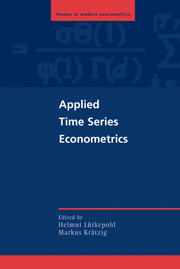Book contents
- Frontmatter
- Contents
- Preface
- Notation and Abbreviations
- List of Contributors
- 1 Initial Tasks and Overview
- 2 Univariate Time Series Analysis
- 3 Vector Autoregressive and Vector Error Correction Models
- 4 Structural Vector Autoregressive Modeling and Impulse Responses
- 5 Conditional Heteroskedasticity
- 6 Smooth Transition Regression Modeling
- 7 Nonparametric Time Series Modeling
- 8 The Software JMu⌉Ti
- References
- Index
8 - The Software JMu⌉Ti
Published online by Cambridge University Press: 23 November 2009
- Frontmatter
- Contents
- Preface
- Notation and Abbreviations
- List of Contributors
- 1 Initial Tasks and Overview
- 2 Univariate Time Series Analysis
- 3 Vector Autoregressive and Vector Error Correction Models
- 4 Structural Vector Autoregressive Modeling and Impulse Responses
- 5 Conditional Heteroskedasticity
- 6 Smooth Transition Regression Modeling
- 7 Nonparametric Time Series Modeling
- 8 The Software JMu⌉Ti
- References
- Index
Summary
Introduction to JMu⌉Ti
Software Concept
This chapter gives a general overview of the software by which the examples in this book can be reproduced; it is freely available via the Internet. The information given here covers general issues and concepts of JMu⌉Ti. Detailed descriptions on how to use certain methods in the program are left to the help system installed with the software.
JMu⌉Ti is an interactive JAVA application designed for the specific needs of time series analysis. It does not compute the results of the statistical calculations itself but delegates this part to a computational engine via a communications layer. The range of its own computing functions is limited and is only meant to support data transformations to provide input for the various statistical routines.
Like other software packages, JMu⌉Ti contains graphical user interface (GUI) components that simplify tasks common to empirical analysis – especially reading in data, transforming variables, creating new variables, editing data, and saving data sets. Most of its functions are accessible by simple mouse interaction.
Originally the software was designed as an easy-to-use GUI for complex and difficult-to-use econometric procedures written in GAUSS that were not available in other packages. Because this concept has proved to be quite fruitful, JMu⌉Ti has now evolved into a comprehensive modeling environment for multiple time series analysis. The underlying general functionality has been bundled in the software framework JStatCom, which is designed as a ready-made platform for the creation of various statistical applications by developers.
- Type
- Chapter
- Information
- Applied Time Series Econometrics , pp. 289 - 300Publisher: Cambridge University PressPrint publication year: 2004
- 3
- Cited by



